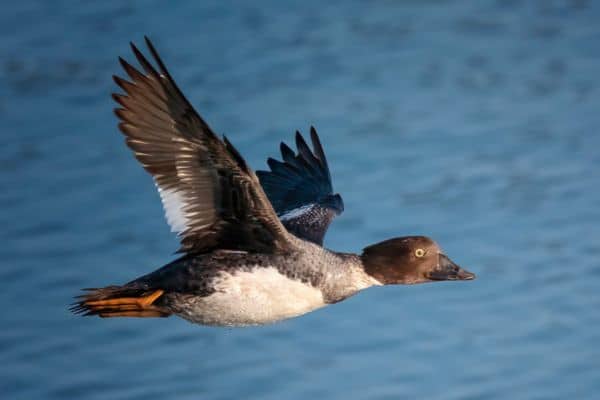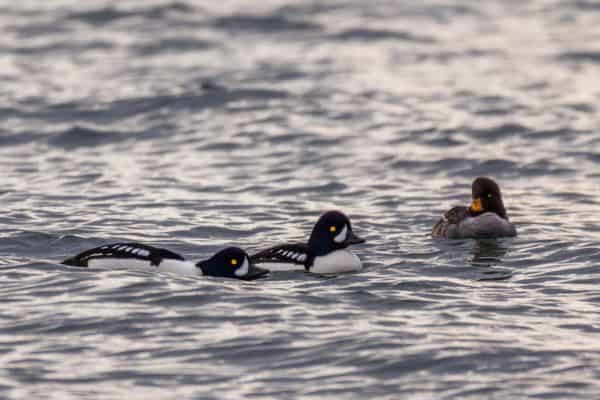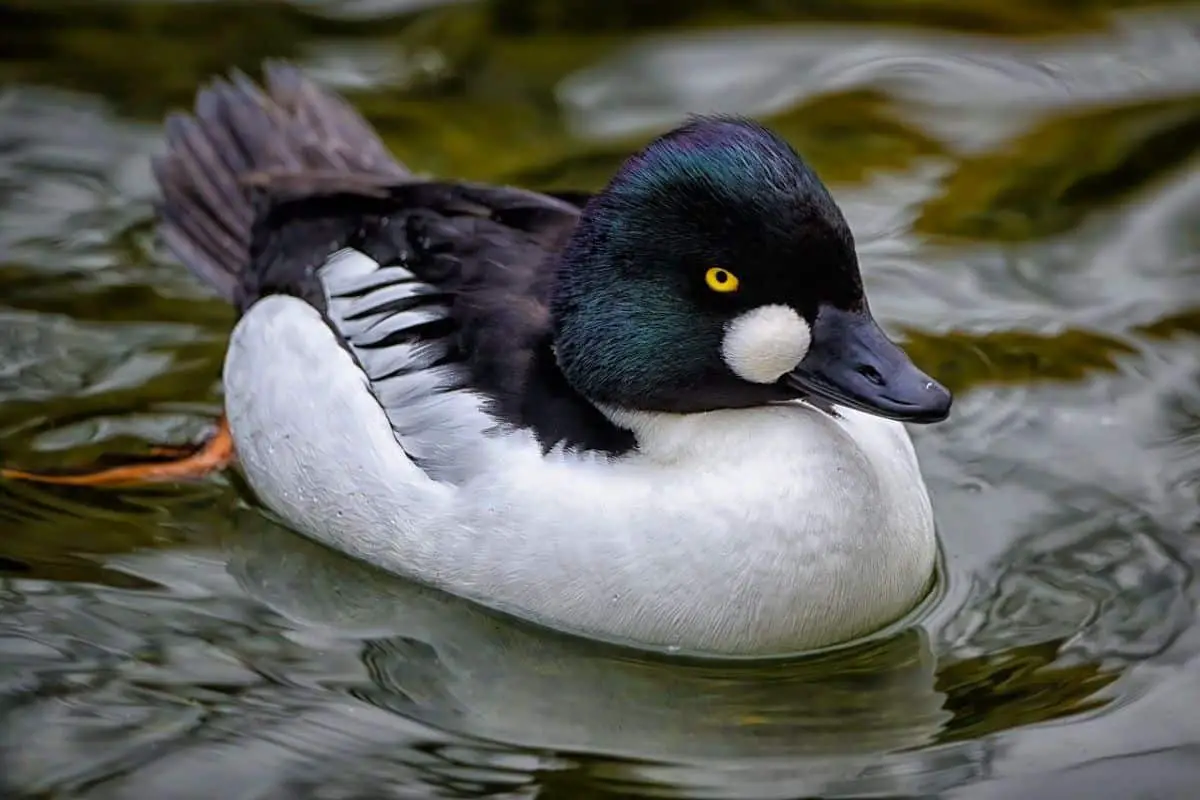Common Name: Common Goldeneye
Scientific Name: Bucephala clangula| Size | Diet | Range in Hawaii | Status in Hawaii |
|---|---|---|---|
| 17 in. - 20 in. | insects, crustaceans, mollusks, and small fish | Oahu | Least Concern |
Introducing the Common Goldeneye (Bucephala clangula), a notable member of the Anatidae family esteemed for its refined appearance and intriguing presence. In this article, we embark on a comprehensive exploration of the Common Goldeneye, delving into its distinct characteristics, behaviors, and preferred habitats. While not indigenous to Hawaii, occasional sightings of this remarkable waterfowl species have added intrigue to the avian landscape of the islands.
Common Goldeneye
Appearance

The Common Goldeneye is a visually striking duck species that exhibits a distinctive and refined appearance. Adult males showcase a glossy green-black head with a round white spot near the base of the bill, which contrasts beautifully with their gleaming white body.
They measure approximately 17-20 inches (43-51 cm) in length, making them a medium-sized waterfowl species. In contrast, adult females feature a more subdued brown plumage with a light-colored oval patch behind the eye. Both genders possess sturdy body and streamlined shape, allowing them to navigate the water with agility and grace.
Diet
The Common Goldeneye has a diverse and specialized diet that reflects its adaptability as a diving duck. These remarkable waterfowl primarily feed on aquatic invertebrates, such as insects, crustaceans, mollusks, and small fish.
They are skilled divers, capable of submerging themselves in search of prey. Using their powerful webbed feet and streamlined bodies, Common Goldeneyes plunge into the water, propelled by their strong wingbeats.
Once submerged, they employ their keen eyesight and agile maneuvering to capture their prey with precision. Their diet may also include plant matter, particularly during the non-breeding season when aquatic vegetation becomes more readily available.
Nesting
The Common Goldeneye engages in intriguing nesting behavior, carefully selecting suitable sites for reproduction. During the breeding season, typically occurring in the northern regions of North America, Europe, and Asia, the female Common Goldeneye seeks out nesting locations near freshwater bodies such as lakes, ponds, and rivers.
The female constructs her nest, often hidden from sight, using materials such as grasses, down feathers, and twigs. Common Goldeneyes have a unique preference for nesting in tree cavities, taking advantage of natural hollows or using abandoned woodpecker holes as their nesting sites. This adaptation allows them to protect their eggs and young from predators and harsh weather conditions.
Once the nest is established, the female lays a clutch of eggs and takes on the responsibility of incubation. She diligently tends to her eggs, ensuring they remain warm and protected. The incubation period lasts approximately 28 to 32 days, during which the female stays devoted to her nest, rarely leaving except for brief periods to feed.
After hatching, the precocial ducklings make their way to the water within a day or two, guided by their mother. The female Common Goldeneye fiercely guards her young, providing them with protection, warmth, and guidance as they navigate their surroundings.
Behavior

The Common Goldeneye exhibits fascinating behaviors that reflect its adaptability and unique characteristics as a diving duck species. These behaviors contribute to their survival and successful navigation of their aquatic habitats.
One notable behavior of the Common Goldeneye is its exceptional diving ability. These ducks can plunge beneath the water’s surface with remarkable agility, using their powerful webbed feet to propel themselves in search of prey.
Their streamlined bodies and specialized adaptations enable them to dive to considerable depths and stay submerged for extended periods. This diving behavior allows them to forage on aquatic invertebrates, small fish, and other prey items found beneath the water’s surface.
During the breeding season, the males engage in elaborate courtship displays to attract females. These displays often involve head-bobbing, wing-flapping, and rapid swimming patterns, showcasing their strength and vitality.
Males also emit distinctive vocalizations as part of their courtship rituals. The Common Goldeneye is known for its social behavior and often forms small to large flocks, particularly during the non-breeding season.
These flocks can be observed swimming and feeding together, creating a dynamic and lively scene on the water. In flight, the Common Goldeneye showcases its agility and speed.
The wings produce a distinctive whistling sound as they rapidly beat, propelling the bird through the air with precision. These ducks are also known for their synchronized flying patterns, with flocks often exhibiting coordinated movements.
Habitat
The Common Goldeneye is a waterfowl species with a preferred habitat centered around freshwater bodies, including lakes, ponds, rivers, and coastal areas. They are commonly found in both inland and coastal wetland habitats, demonstrating their adaptability to diverse environments.
In freshwater habitats, Common Goldeneyes are often seen in areas with submerged vegetation, where they can dive and forage for their preferred prey of aquatic invertebrates and small fish. These ducks are well-suited to habitats with clear, clean water, as it provides optimal visibility for their diving and hunting activities.
During the breeding season, the Common Goldeneye exhibits a particular affinity for nesting near freshwater bodies with nearby forested areas. They often choose nesting sites in tree cavities or take advantage of existing woodpecker holes. This preference for tree cavities provides protection for their nests and young, shielding them from predators and inclement weather.
Coastal habitats also attract the Common Goldeneye, especially during the non-breeding season. They can be observed in estuaries, bays, and coastal lagoons, where they take advantage of abundant food resources and the milder winter conditions.
Range
The Common Goldeneye is not native to Hawaii. While its natural range primarily encompasses northern regions of North America, Europe, and Asia, occasional sightings of the Common Goldeneye have been reported on the island of Oahu in Hawaii.
Conservation Status

The conservation status of the Common Goldeneye is generally favorable, as it is classified as a species of “Least Concern” by the International Union for Conservation of Nature (IUCN). This designation indicates that the species is not currently facing any significant threats that would warrant a higher conservation status.
The Common Goldeneye has a large and stable population distributed across its extensive range, which includes North America, Europe, and Asia. These ducks have shown adaptability to various freshwater habitats and have demonstrated resilience in the face of environmental changes.
Interesting Facts
1. Striking Appearance
The Common Goldeneye is renowned for its striking appearance. The males have a glossy black head with a circular white patch on each side, contrasting with their bright yellow eyes. Females, on the other hand, exhibit a more muted brownish coloration with a white oval patch behind the eye.
2. Excellent Divers
Common Goldeneyes are exceptional divers, capable of diving to considerable depths in search of prey. They can stay submerged for up to 10-55 seconds, using their webbed feet and agile bodies to navigate underwater.
3. Precise Flying Skills
In flight, Common Goldeneyes showcase their agility and speed. They can reach speeds of up to 55 miles per hour (88 kilometers per hour) with their rapid wing beats. Their flight is accompanied by distinctive whistling sounds produced by their wings.
4. Protective Mothers
Female Common Goldeneyes take on the sole responsibility of incubating their eggs, which typically hatch after 28-32 days. The mother leads her ducklings to water within a day or two of hatching, providing them with guidance and protection.
5. Adaptability to Winter Conditions
These ducks are well-adapted to cold climates and often remain in their breeding range during winter months when other waterfowl species migrate to warmer areas. They can withstand freezing temperatures and continue foraging in areas where ice covers the water’s surface.
Frequently Asked Questions
1. Do Common Goldeneyes migrate?
Yes, Common Goldeneyes are migratory birds. Some populations migrate long distances between their breeding grounds in the north and their wintering areas in milder climates.
2. Where do Common Goldeneyes nest?
Common Goldeneyes nest in tree cavities, often using natural tree hollows or abandoned woodpecker holes. They line the nest with down feathers to provide insulation for the eggs.
3. Are Common Goldeneyes social birds?
Common Goldeneyes are typically seen in small flocks, especially during the non-breeding season. However, they can be territorial during the breeding season when competing for mates.
4. Can Common Goldeneyes be found in Hawaii?
While the Common Goldeneye is not native to Hawaii, occasional sightings of this species have been reported on the island of Oahu, adding interest to the avian diversity of the area.




